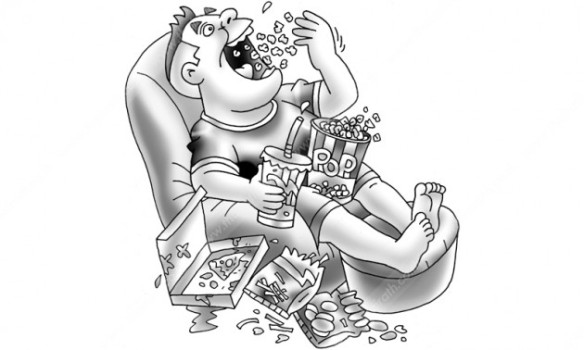 วารสารวิชาการการตรวจสอบความดันโลหิตของสหรัฐฯ ได้กล่าวเตือนว่า ไม่ควรจะนั่งไขว่ห้างนานๆนัก เพราะจะทำให้ความดันโลหิตเพิ่มสูงขึ้นอาจทำให้ความดันเลือดตัวบนเพิ่มสูงขึ้นเกือบร้อยละ 7 และตัวล่างเพิ่มอีกร้อยละ 2
วารสารวิชาการการตรวจสอบความดันโลหิตของสหรัฐฯ ได้กล่าวเตือนว่า ไม่ควรจะนั่งไขว่ห้างนานๆนัก เพราะจะทำให้ความดันโลหิตเพิ่มสูงขึ้นอาจทำให้ความดันเลือดตัวบนเพิ่มสูงขึ้นเกือบร้อยละ 7 และตัวล่างเพิ่มอีกร้อยละ 2
แพทย์โรคหัวใจผู้เชี่ยวชาญหมอสเตเฟน ที สินาตรา ยังสะกิดเตือนว่า การนั่งไขว่ห้างบ่อยๆยิ่งจะทำให้ข้อต่อสะโพกต้องรับน้ำหนักมากขึ้นและทำให้เลือดคั่งอยู่ที่ขาเพราะเส้นเลือดถูกกดทับ ซึ่งอาจจะทำให้เส้นเลือดแถวปลายขาอักเสบและเกิดลิ่มเลือดอุดตันได้
เขากำชับไว้ว่าไม่ควรนั่งไขว่ห้างนานเกินกว่าพักละ 10-15 นาทีและควรจะลุกขึ้นเดินเสียทุกๆครึ่งชั่วโมง.
ที่มา: ไทยรัฐ 25 กุมภาพันธ์ 2557
.
Related Article:
.
How Crossing Your Legs Hurts Your Heart
By LINDA MELONE
Prevention
Feb. 20, 2014
You eat well, you exercise, and you even get the right amount of sleep (most nights, anyway; no one’s perfect). But chances are, you’ve got some other little habits that are costing you in the health department—without you even knowing.
You cross your legs
Sitting with legs crossed at the knee can bump up blood pressure, according to a study published in Blood Pressure Monitoring. Leg crossing increased systolic blood pressure nearly 7 percent and diastolic by 2 percent.
“Frequent crossing of the legs also puts stress on the hip joints and can cause pooling of blood in the legs when the veins are compressed,” says Stephen T. Sinatra, MD, FACC, a Connecticut-based cardiologist and author of The Great Cholesterol Myth. “This could predispose you to inflammation of the veins of the lower legs and possibly a blood clot.”
Dr. Sinatra says to avoid crossing your legs for longer than 10 to 15 minutes, and to get up and walk around every half hour or so.
You stand with locked knees
It may feel easier to stand with your knees locked, but it increases stress on the knee joint.
“All of our joints are stabilized by activation of the surrounding muscles,” says David W. Kruse, MD, an orthopedic specialist with Hoag Orthopedic Institute in Irvine, California. “When you stand with knees locked, you are no longer efficiently using the muscles that surround the joint. Consequently, forces to the joint are increased.”
When you stand, do so with your knees slightly bent.
You sleep on your stomach
Snoozing on your stomach puts your neck in a tilted-back position, which can lead to pain or numbness in your upper extremities, says Richard Lee, MD, a spine surgeon at Hoag Orthopedic Institute. Nerves become compressed in this area when the head tilts back, which can lead to pain or numbness.
“Simply change sleeping positions such that the neck is no longer tilted backward during sleep,” says Dr. Lee.
See a doctor if symptoms remain.
You wear your belts tight
A tight belt may cinch your waist, but it can backfire on you in the form of digestive issues: Your snug belt creates intra-abdominal pressure, which can result in acid reflux (GERD), says Patrick Takahashi, MD, chief of gastroenterology at St. Vincent Medical Center in Los Angeles.
Symptoms of GERD can range from something as small as a bitter taste in the mouth, to a burning or pain in the chest or upper stomach region, chronic cough, or even difficulty swallowing. Dr. Takahashi recommends wearing your belts no tighter than the waistband of your pants.
“You should be able to inhale and exhale comfortably with the belt tightened,” he says.
You slouch
Slouching can lead to shoulder pain or impingement when the rotator cuff muscles (shoulder stabilizers) become compressed against the shoulder blade, says David Geier, MD, an orthopedic surgeon in Charleston, South Carolina. Poor posture could also lead to a muscle imbalance that can contribute to further compression.
Check your posture: While standing sideways to a mirror, you should be able to run an imaginary line through the center of your ear, shoulder, hip, knee, and ankle.
You drive long distances without a break
Motoring for many miles without stopping can have a similar effect to crossing your legs, where you get blood pooling in the legs that can lead to clotting, says Dr. Sinatra. After driving for about 100 to 150 miles, stop the car and go walk around to improve blood flow and reduce inflammation. Do the same when flying long distances.
“Getting up and going to the bathroom is one of the healthiest things you can do on a flight,” says Dr. Sinatra.
You stretch as soon as you get up
Back stretches first thing in the morning can put the discs in your back at risk, says Ted Dreisinger, PhD, FACSM, researcher and managing partner with Therapy Advisors, consultants specializing in the treatment of chronic back and neck pain.
“Spinal discs become hydrated during the night, which creates more pressure on them when you first wake up. This also makes them more prone to stresses such as stretching.”
Warm up with small activities (getting coffee, brushing your teeth) for about 10 minutes before stretching.
You hold off on using the restroom when nature calls
If you delay using the bathroom for prolonged periods of time, you may be putting yourself at risk for developing urinary tract infections.
“UTIs can result due to a woman’s shorter urethra and close proximity to the vagina,” says Riya Pulicharam, MD, director of clinical research for Healthcare Partners Medical Group in Los Angeles. “Bacteria in the urine can multiply very quickly, so holding urine for prolonged periods can lead to infections. Listen to your body.”
You chew gum
You may want to ditch the gum if you find yourself with a sore jaw at the end of the day, says Don C. Atkins, DDS, a family dentist in Long Beach, California.
“The jaw joint is designed to chew food, not gum. The time you spend chewing food each day is much less than the many minutes some people chew gum,” he says.
Like any overused muscle, constant chewing can lead to pain and problems. Pops and clicks in the jaw joint can indicate jaw joint damage, says Dr. Atkins. “Give it a rest, especially if you hear sounds or feel tenderness in the jaw.”
You carry your purse the same way every day
It may be stylish, but carrying a heavy bag over the same shoulder day in and day out can eventually result in muscular imbalances and shoulder pain.
“Many pain syndromes result from people doing asymmetrical repetitive activities,” says Dr. Kruse. “All repetitive activities require the development of muscles to support the movement pattern. This can create significant muscle imbalances that result in injury or chronic pain.”
Alternate with the opposite shoulder or lighten up your baggage.
SOURCE : abcnews.go.com

















